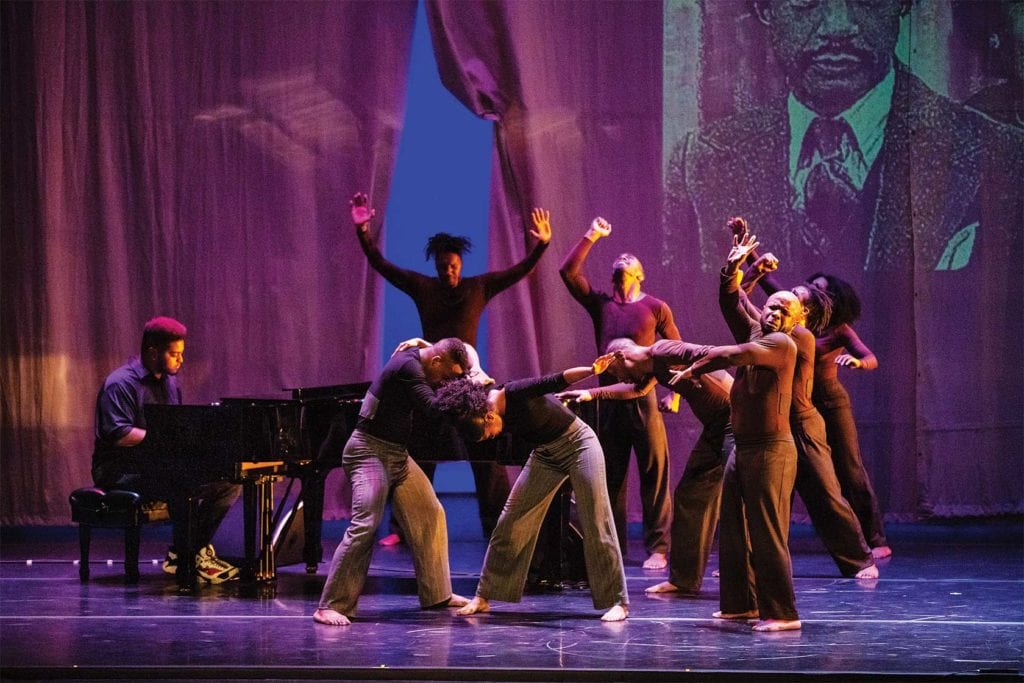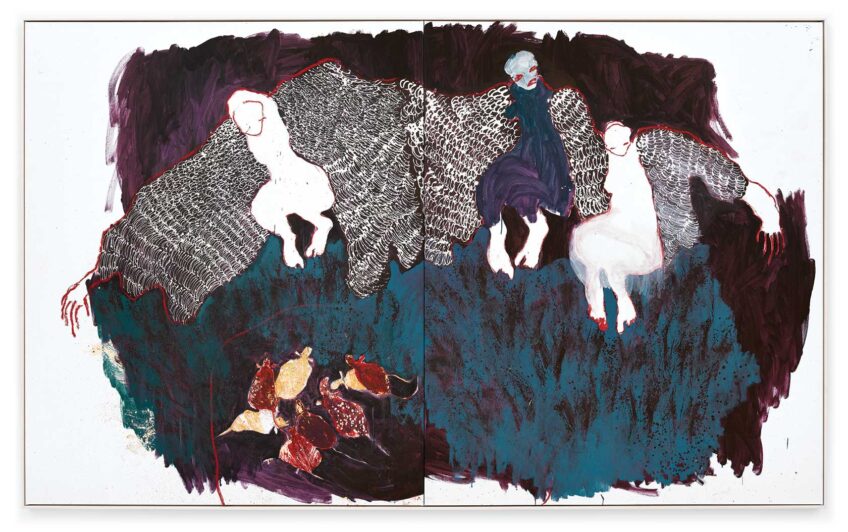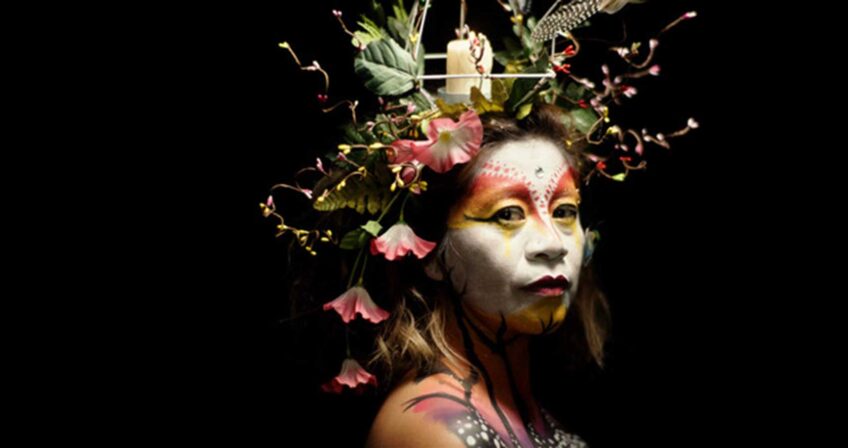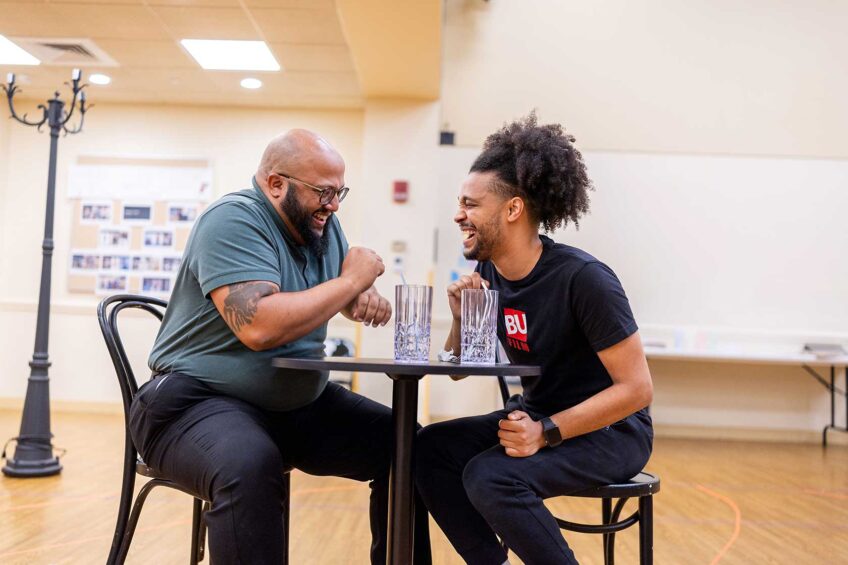Camille A. Brown & Dancers in Celebrity Series debut
Performance draws on African rhythms and rituals

Camille A. Brown and her company Camille A. Brown & Dancers began their Celebrity Series of Boston debut at the Boch Center Shubert Theatre Saturday night by summoning the gifts, legacy and complicated history of black performers.
Unfolding like a family album, images were projected behind the dancers that varied from grainy archival footage of minstrel shows and cakewalk pageants to vintage photos of cinema maids and butlers and video clips of TV comedians of the 1950s and ’60s. Meanwhile, an eight-member ensemble performed a torrent of complex and supple movements in unison, pairs and solos, white sneakers highlighting fast feet, to rhapsodic, propulsive live piano music.
This juxtaposition of a precious, hard-won history with an exuberant present made for a captivating multimedia experience and a thrilling demonstration of the company’s mission.
The 30-minute performance was an excerpt from Brown’s Bessie Award-winning “Mr. TOL E. RAncE” (2012), the first work in her trilogy about culture, race and identity and the sustaining power of dance and music traditions rooted in the African diaspora. The program also presented brief excerpts from the trilogy’s other works, the Bessie-nominated “BLACK GIRL: Linguistic Play” (2015) and “ink” (2017), and concluded with the 10-minute “New Second Line” (2006), a post-Katrina tribute to the people of New Orleans and their enduring spirit and culture.
Each work draws on rhythms, rituals, and movement vocabulary of the African diaspora, a shared, living vocabulary emerging from two centuries of African and African American movement traditions. “The present always contains the past,” Brown says in her TED-Ed talk, “A Visual History of Social Dance in 25 Moves,” which has had more than 16 million views. “And the past shapes who we are and who we will be.”
Brown, 40, is a dancer, choreographer, director, and dance educator. The recipient of four Princess Grace Awards, a Doris Duke Performing Artist Award, a Jacob’s Pillow Dance Award and a Guggenheim Fellowship among other honors, Brown is a Ford Foundation Art of Change Fellow and a TED Fellow. She has created concert dance works for such companies as Alvin Ailey American Dance Theater, Philadanco! and the Urban Bush Women. Brown choreographed the Metropolitan Opera’s “Porgy and Bess,” as well as the Emmy Award-winning “Jesus Christ Superstar Live in Concert,” the Tony Award-winning “Once on This Island,” and “Choir Boy,” for which she earned Tony and Drama Desk Award nominations.
Brown’s choreography draws from the inventiveness of enslaved Africans. Denied their makeshift drums, they sustained their rhythmic traditions and spirits by creating music with stomping feet and slapping bodies, known as “patting Juba.”
Ardent in outreach and education, in Boston Brown met with the Boston Network of Arts Administrators of Color at Darryl’s Corner Bar & Kitchen in the South End, and company members conducted a free dance workshop, “Double This, Juba That!,” at Roxbury’s Hibernian Hall for 75 boys and girls from local youth programs and dance studios. They learned some of the hand-clapping, double dutch, juba, steppin’ and ring shout games showcased in Brown’s “BLACK GIRL: Linguistic Play.”
Imaginative online study guides for “Mr. TOL E. RAncE” explore the cultural history of the dances as well as the piece’s multiple inspirations, including Spike Lee’s movie “Bamboozled” and the Mel Watkins book, “On the Real Side: From Slavery to Chris Rock.”
The evening’s gorgeous music, like its choreography, is an amalgamation of many styles and traditions emerging from the African American diaspora, including the music that is one of this country’s greatest gifts to the world: jazz.
On stage with a grand piano, Kwinton Gray played segments of the score composed by Scott Patterson, Brown’s frequent collaborator, for “Mr. TOL E. RAncE,” her evening-length work of dance theater. Accompanying the half-hour excerpt, Gray played “The Overture” and “Showtime,” lyrical, arpeggio-rich compositions that lent a reflective note to the spectacle of eight young dancers performing exuberantly before memory-laden images of their ancestors. Celebrating the past with affection, the work asserted the present with power and joy.
Following an intermission were brief excerpts from the second and third works in the trilogy. Both told stories through duets and both drew from inherited protocols and gestures that are still part of daily neighborhood life.
Performed on a tap-dance platform by Brown and Catherine Foster, the excerpt from “BLACK GIRL: Linguistic Play” was unaccompanied by piano. Instead, they made music with their chanting vocals; rippling, shuffling and stomping feet; snapping fingers; and slapping hands that, patting Juba, turned their bodies into a beatbox.
The two appeared as birds in full plumage: Brown in tropical hues, from her regal head wrap to her sunny yellow top and party-ready skirt; and Foster, projecting earthy elegance with her crown of braids and a plaid lumberjack shirt wrapped around her waist.
Ready for business, they sized one another up with a quick glance and plunged into testing and then merging each others’ mastery of the shared language of tapping feet. As they ascended into an ecstatic duet, they held hands in a give-and-take of complex, rapid rhythms, each her own person while sharing, trading and building on her partner’s inventions.
Next came “Turf,” an 11-minute segment from “ink” that also tells a story of bonding, this time between men. Gray introduced the work with a spare melodic line, setting the stage for an expressive solo by Maleek Washington, attired in a spiffy basketball jersey, who with dexterously playful and awkward moves portrayed a boy in need of a friend. Joining him was Timothy Edwards, in loose, game-ready attire. In a deft theatrical duet, silent but for shuffling feet, the pair celebrated the rituals and gestures of male bonding over a span of years, at first on a basketball court, and later, as they encounter the pain of a wider world (Washington, in one scene, seems to choke, an echo of “I can’t breathe”), backed by friendship.
The entire company performed “New Second Line,” evoking the street dancers who trail the brass bands that accompany wedding and funeral processions, while pianist Gray wove melodic lines into a jubilant recording by Los Hombres Calientes, a musical gumbo of Crescent City flavors rooted in parade rhythm.
All returned to rousing applause and began dancing again. Then one by one, each performer saluted the audience with a split-second signature move. Each time, all company members then put loving hands on the dancer.






